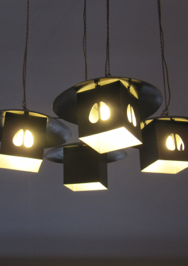the Willows Tea Room
217 Sauchiehall Street
glasgow, Scotland
United Kingdom
september 27, 2010


the Willows Tea Room
217 Sauchiehall Street
glasgow, Scotland
United Kingdom
september 27, 2010




At the top on our list of places to see in Glasgow was The Willows Tea Room on Sauchiehall Street, a pedestrian shopping street in the center of the city. The name of the street, meaning “Alley of the Willows” in Gaelic, inspired the name of the tea room. Henry and I planned our day around a break for tea in a building designed by Charles Rennie Mackintosh. This building was considered to be the crown of his twenty year partnership as architect and designer for Mrs. Kate Cranston, his most generous and consistent patron. Between 1897 and 1917, he designed or restyled rooms in all four of her Glasgow tea establishments. Amongst the designs commissioned were:
•1897: Tea Rooms at 91-93 Buchanan Street. Wall murals were commissioned to be designed by Mackintosh. Furnishings were designed by George Walton.
•1898: Argyle Street Tea Rooms. Furniture and Interiors were commissioned to be designed by Mackintosh. George Walton designed the wall murals.
•1900: Ingram Street Tea Room: Cranston commissioned Mackintosh to redesign an entire room. Here he created the White Dining Room. He separated the entry hallway from the room, where visitors could catch a glimpse of the room through a wooden screen with glass inserts.
•1903: Willows Tea Room at 217 Sauchiehall Street. He was commissioned here to design the exterior, the internal layout of the narrow, 5 story building, and all of the interior fittings. The interior consists of various tea rooms, two major dining rooms, a dining gallery, and a timber-paneled billiards room on the top floor. This was the only tea room building where Mackintosh had complete control over every aspect of the design. His designs also included the teaspoons and waitresses dress. His Room de Luxe was the main attraction with its silver furniture and leaded mirror friezes, so exclusive that customers were willing to pay a penny more for their cup of tea. While the Room de Luxe was bright and feminine, the Gallery was darker and masculine.
•1911: Ingram Street Tea Rooms: Mackintosh redesigned some rooms and created the Chinese Room in an existing space. This room incorporated a series of vertical and horizontal lattice style screens, designed to reduce the high ceiling and increase the room's intimacy. He fixed wooden lattice type screens to the walls, which were lined with hessian, and supports filled with mirrored glass and red and green plastics on which the overhead canopies rested. The room was painted a very vivid blue and the distinctive oriental style chairs and bench seating were upholstered in blue corduroy.
•1917: Following the death of her husband, Kate Cranston sold her businesses and the buildings were subsequently put to other uses.
The recreation of the Willows Tea Room in 1997 and its expansion to Buchanan Street, now gives the visitor a chance to experience Mackintosh’s tea room interiors and the beauty of his designs. Henry enjoyed tea on the gallery of the building at 217 Sauchiehall Street, which has been re-created in its entirety. The expansion contains two of Mackintosh’s special rooms originally built for the Ingram Street Tea Rooms: the bright, White Dining Room filled with high backed chairs and leaded glass, and the Chinese Room, dark and atmospheric.
PHOTOS: Left Column: 1. The sign for the Willows Tea Room at 217 Sauchiehall Street in Glasgow. 2. A view of the Room de Luxe, positioned at the 2nd floor (USA: 3rd floor) bowed window of the 5 story building. 3. The Mackintosh designed screen behind which the tea is brewed. 4. Painted, stenciled, and applied lathing detail of the walls in the Gallery tea room at 217 Sauchiehall Street. Center, Top: The leaded glass and mirror frieze in the Room de Luxe at 217 Sauchiehall Street, designed by Mackintosh. Center, Bottom: A glimpse of a cozy corner in the Room de Luxe. In this tight space, the fireplace with its odd shaped mirror above can be seen between the high back silver-painted chairs. Right Column: 1. The white stuccoed exterior of the 217 Sauchiehall Street building, designed by Charles Rennie Mackintosh. 2. Ceiling fixtures in the Room de Luxe at 217 Sauchiehall Street, designed by Mackintosh.


“Alley of the Willows”




